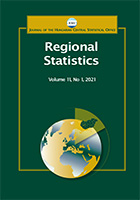Exchange market pressure in Sub-Saharan African countries – The role of imports and short-term external debt, 2002–2017
Exchange market pressure in Sub-Saharan African countries – The role of imports and short-term external debt, 2002–2017
Author(s): Senanu K. Klutse, Gábor D. Kiss, Judit SágiSubject(s): Social Sciences, Economy, Geography, Regional studies
Published by: Központi Statisztikai Hivatal
Keywords: exchange market pressure; imports; short-term external debt; foreign reserve adequacy
Summary/Abstract: The loss in the value of domestic currency could be destabilising in most developing countries. To avoid exchange rate crises, countries intervene in foreign exchange markets. While attempting to measure the exchange market pressure (EMP) that leads to a currency crisis, various studies discovered that international reserve variable alone or its variations perform well in explaining changes in the exchange rate variable in developing economies. However, no study has used foreign reserve adequacy to derive an effective measure in capturing EMP in developing and emerging countries from 2002 to 2017. To measure this phenomenon, this study proposed innovative approaches based on the foreign reserve to import ratio, foreign reserve to short-term external debt ratio, and foreign reserve to broad money ratio. Using a generalised method of moments regression model and a ridge regression model, this study found that the new measures of the EMP index with the reserve variable adjusted for imports and short-term external debt are suitable for identifying EMP in Sub-Saharan Africa. This study recommends the combined use of these innovative approaches because a currency crisis can emanate from any account of a country’s balance of payments.
Journal: Regional Statistics
- Issue Year: 12/2022
- Issue No: 04
- Page Range: 92-111
- Page Count: 20
- Language: English

